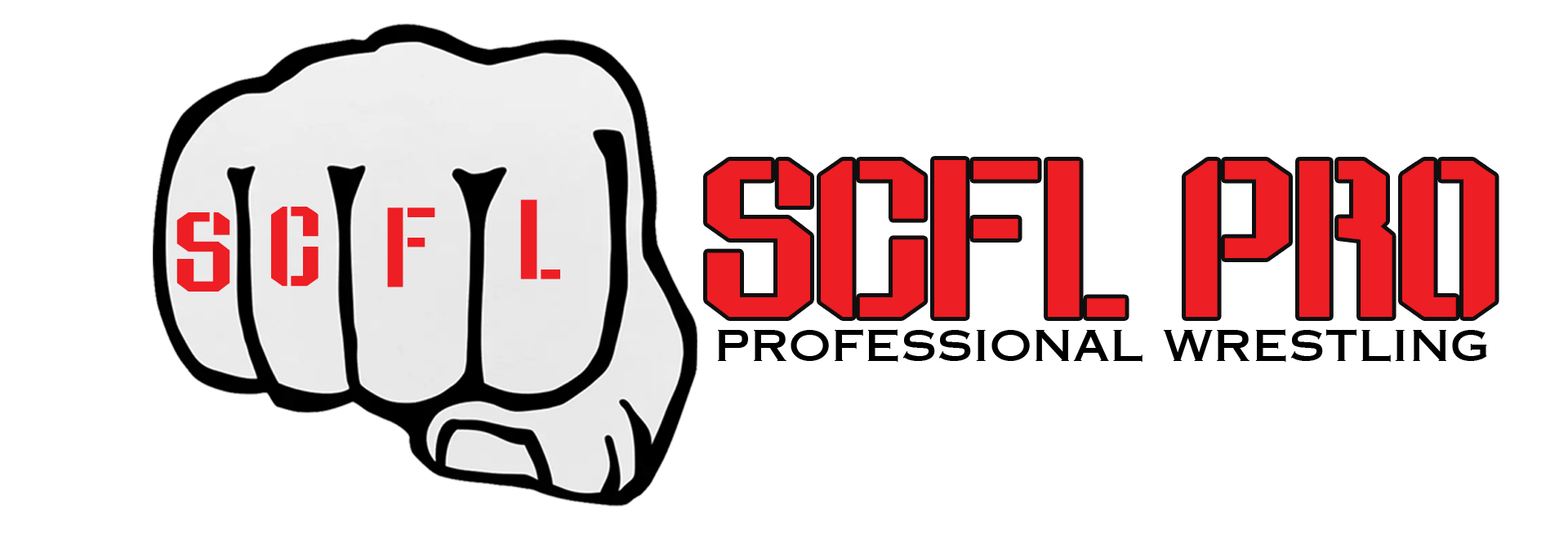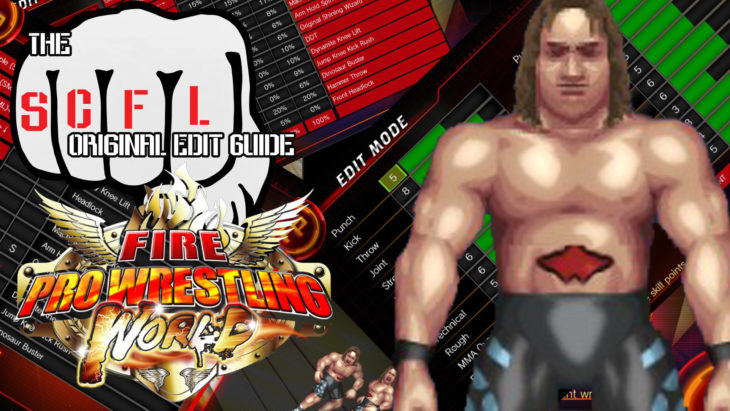
GUIDE: CPU Logic in Fire Pro Wrestling Wold
There is a certain level of mysticism that comes with Fire Pro Wrestling’s CPU logic that either scares off newcomers or forces someone to dive deeply into tweaking numbers in fits of madness only to find a character not quite doing what they believe it should be doing.
This is the second guide, a companion to Creating Your Own Original Fire Pro Wrestling World Character.
Everyone has downloaded a character on the Workshop only to find it looking good, that the move set mostly makes sense, but when it comes to the actual matches it’s a mess. Most of the time that is because the creator was intimidated by CPU logic, lazy or just wasn’t comfortable enough to make the character actually work. Moves and stats are important parts of making an edit tick, but the reality is that a 50-point edit with finely-tuned logic could beat a 300-point edit without much care or thought put into it. There’s not much left to the imagination anymore in regards to how logic works thanks to Fire Pro being on PC, being easily moddable and creators getting to crack the game wide open to see its insides.
There are people like Critical Club’s Soak that have sifted through the numbers and have a measured, metric-based approach to creating edits and you should absolutely check out the info that he’s posted, but I’ll warn you right now that I don’t operate like that and instead a lot of how I create characters and handle logic is based on intuition and 20-something years of experience with tweaking edits to do what I want them to do.
You Are Not God, You Do Not Control the Random Number Generator
I’m starting off with this one because I’ve known a lot of people that drive themselves to the brink of madness tweaking logic on their characters, running endless simulations and still not finding what they want for a certain character. First of all, You need to have a vision of what the character is, who they are and how they should act. While it’s fun to think about stringing together combinations and finding ways to win, unless your intent is to run “shoot” simulations you’re doing yourself a disservice.
You are certainly not the god of Fire Pro and you do not control what the random number generator spits out. Setting stats, moves and logic is how you influence the God King that is the RNG, but it’s always a suggestion, not a hard-and-fast rule. If you have a move at 10% at front grapple that means that there’s a 10% chance of that move happening during a front grapple as long as said character wins the roll of the dice. So, when two characters lock up, say there’s a 50% chance of character A winning the grapple and a move is at 10%, that means overall it’s a 5% chance of seeing it. That doesn’t mean that you won’t see it. Sometimes 10% on a front grapple means you’ll see it twelve times in a match, other times it means you’ll never see it in a match, or even in a series of matches.
As much as I and others can give you advice of how to make your character work, think of how the game works and that you are not actually in control of it. The best that you can do is put in some time and effort and hope that it works out.
Your Goal is Entertainment
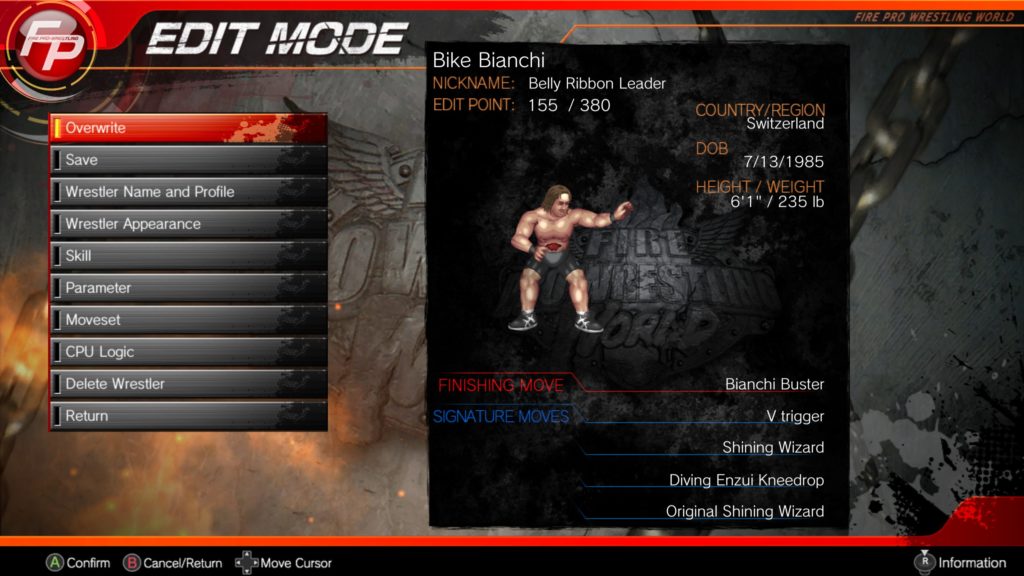
This is really the first lesson that most people should try to understand when creating a character in Fire Pro. Understanding that you want to simulate matches between characters should come with an idea of what you want to see out of pro wrestling. When I ran a collaborative e-fed many years ago we had logic rules in place, which I had tweaked from LordVermin’s EFW logic rules. In a lot of ways I still loosely adhere to these rules (which I can’t for the life of me find, but wrestling has changed a lot over the years and the idea of what wrestling should be has also change. Wrestling and how you create your edits will always be a matter of taste.
I have an old set of guides that were specific to my e-fed at the time which have been quoted and shared a bunch since 2005/6 called “Shit You Should Know,” which are pretty good, but also riddled with in-jokes.
There’s one on moves. One on logic. If you can get past some of the references that only a handful of people will remember they’re still mostly useful.
Your goal in creating an edit (or a series of edits) is to emulate professional wrestling in this weird, limited game, which somehow is able to do an admirable job of this. As with any other creative endeavor, I strongly recommend you spend time with other people’s creations, poking around under the hood and copying before going full steam ahead with your own. You can find a collection of SCFL edits on Steam that all tend to work really well together. That’s how they were made. Some better than others, obviously. If you’re on PS4 there’s currently only Bike Bianchi, but he’ll be the example that I use in here, as well, so don’t worry.
Brass Tacks: Moves
So here’s what you’re here for, right? The actual numbers and best practices behind making Fire Pro edits. For this example I’m going to use Bike Bianchi, linked above. You don’t need to necessarily know who the character is or have seen his matches, although it may help, but I’ll help fill in any blanks and give you the reasons behind logic choices.
Stand Back (Stall)
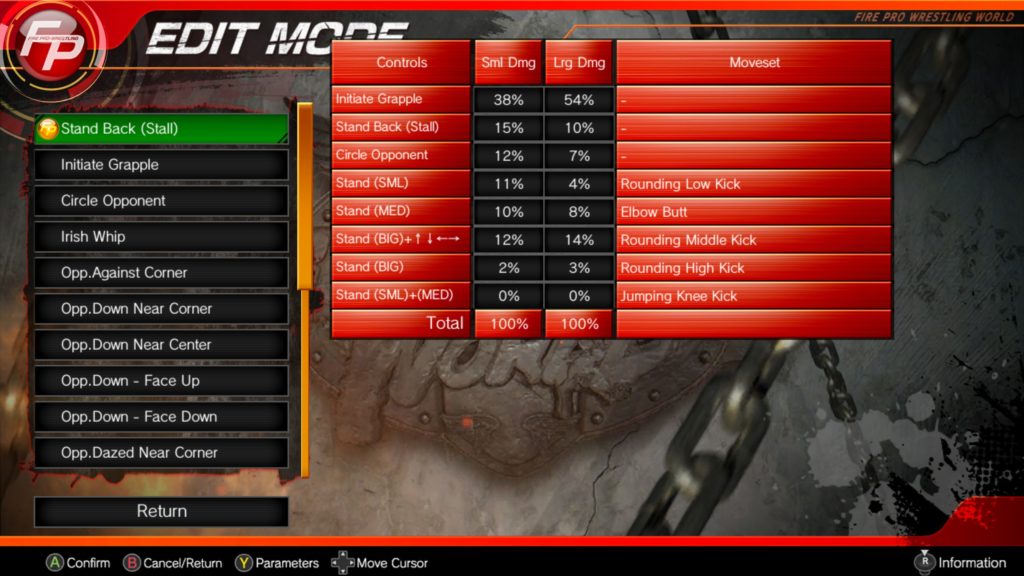
This is your basic “ready” position. From here your character can choose to strike, grapple or stall. This impacts the pacing of the match and is broken down into two, broad categories of “small damage” and “large damage.” Small takes up the first half of the match, large the second. Bike Bianchi is not a violent man, he’s a sad, meak and meager man, so logic is set accordingly here and not exactly standard at all times. As the match wears on, he gets a bit more aggressive because he just wants to get it over with. He takes dumb risks and gets hurt a lot because he’s acting out of fear, not heroism.
Initiate grapple is something that you should set your baseline at about 50%. Bike’s base is kickboxing, so he has higher logic on standing strikes that can actually land, but won’t do a ton of damage. Everyone wants longer matches in Fire Pro and stats play a big role in that, but if your character has one thing they rely on most, like kicks for Bike, remember that the higher the stat and the higher the logic on those strikes the quicker the match moves. So he has a low kick, middle kick and an elbow strike, all in the 10% range. There’s a high kick at 2% and 3% respectively, but the jumping knee has 0 across the board. Those moves work best for standing dazed, where they can actually hit. There’s a chance a random flying knee could connect, but the regular distance that edits keep in a standing position makes that improbable and the flying knee will most likely overshoot and he’ll look stupid. If that’s what you’re going for then, by all means, do it. I tend to keep low single digits on some of these moves just to spice things up and because they’ll occasionally connect.
Then there’s “stand back (stall)” and “circle opponent.” These two are ones that are usually avoided by most edit makers, but can add a lot of personality to your character if used properly. The general rule of thumb was always to set them around 10% and leave them alone. If you’ve ever set the logic higher on these, you’ve probably noticed that the match slows down and your character is basically running away. Check out Ron Harris on the Steam Workshop for an example of a character with high stall and circle. The intent is that Ron is not a fighter and is deathly afraid of getting hurt. Circle is good for pure strikers as they’ll circle around the opponent to look to set up strikes, while stall is literally backpedal away from the opponent, think classic heels like Jerry Lawler or someone like Toru Yano.
If you aren’t feeling adventurous, set them at 10% or so and forget about it.
Initiate Grapple/Circle Opponent
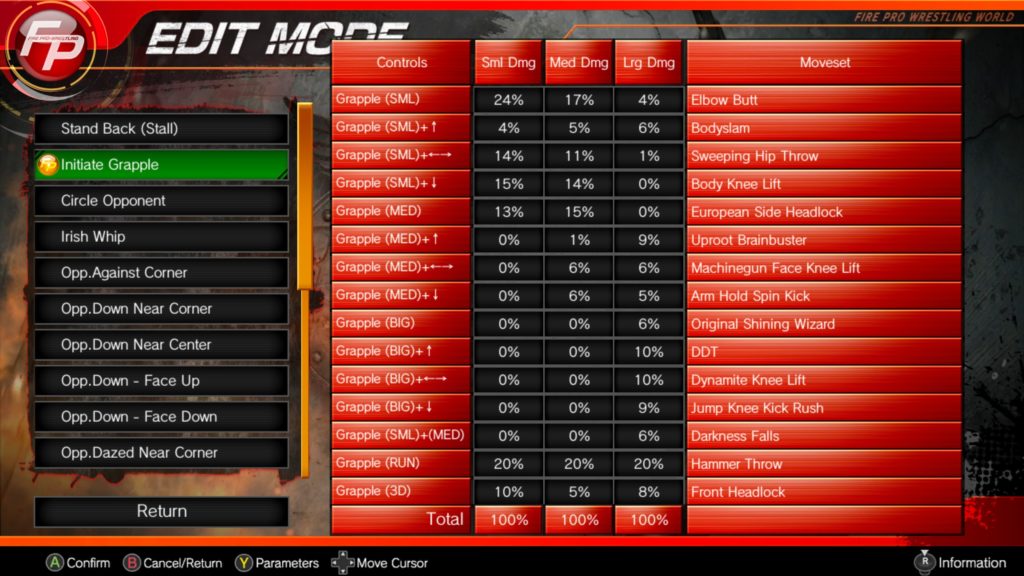
I’m going to combine these two as they are both your standard grapples and follow the same basic ideas, except back grapple has less moves available and logic tends to be higher because of that.
This is where you get to control a lot of how your character interacts with others. Now, I’m perhaps a bit more conservative with how my character does moves because I tend to prefer wrestling that is a bit slower and more deliberate in nature. Think 90’s Strong Style with a lot of strikes and wear down holds to start a match. Bike is a striker by nature, which means I lean heavier on strikes in the logic. My philosophy has always been to always have small strikes that are utilized throughout the entire match, sometimes as the main focus. Bike will use the small elbow strike throughout the entire match. 24%/17%/4% respectively. At small damage alone he has 39% of his logic set to do a small strike. 13%/15%/0% for the European Side Headlock, which is a weardown hold. The idea is that the beginning of the match starts off with deliberate striking and wearing down. Medium and large grapples remain at 0 at small damage because chances are, you don’t want to start a wrestling match off with one of your biggest moves.
That isn’t exactly a bad thing, mind you, as classic NWA and King’s Road style always saw big matches start off hot with a few big moves before simmering down into the weardown portion of the match. The truth here is that Fire Pro does a poor job at that. Moves in those higher slots do more damage and landing them early means making the matches shorter. If that’s what you want then I encourage you to test that out. Note that a lot of the time I’ll have a weardown hold in BIG grapple, like a cobra twist or something similar, where the logic will basically replace the spot of the European Side Headlock that Bike has.
There’s also hammer throw at 20% across the board and the front headlock at 10%/5%/8%. Think of the hammer throw as a way to change the position of where the match is happening, allowing you to access the corners, the outside of the ring or just re-center. It also gives you access to six other moves. Sometimes it’s good to just break up the rhythm of the match with that, or maybe the character has a move featured as a running or vs. run move.
At large damage is where I finally introduce those big grapple moves and you’ll note that I don’t go above 10% on any of them. I also (finally) introduce his medium grapple suplex. While I tone down on the smaller strikes and lean heavier on the medium ones, a lot of that has to do with Bike, who uses a lot of knee strikes and kicks, which simply aren’t available at small grapple as they are in medium and big.
As for Specials or Finishers, the Original Shining Wizard is a special and Darkness Falls is the finisher. Both are set to 6% with the reasoning behind that being you want those moves to have impact when they happen, to feel special and like they might finish the match. The lower the logic, the less likely that they’ll happen. The game also starts to lower damage multipliers from being marked as a special or finisher after they are done repeatedly, which is a good reason to not spam them unless there’s a specific reason for that. I tend to keep finishers very low, with Bike’s 6% being a bit high for me, usually, but it works for his character to maybe use it twice because he’s not strong enough to make it work the first time. At least one of those knee strikes is priority linked to a top rope knee strike. That’s just Bike.
Back grapple is very similar, except instead of 15 choices there are 7. Bike has no specials from a back grapple, so it is mostly about using those to keep the match fresh. The twisted backdrop is set pretty high, but it’s a matter of Bike not actually going for back grapples that often. Remember that logic is a matter of numbers interacting with each other. If your character goes for more back grapples, 30% is a fair limit to consider.
Irish Whip
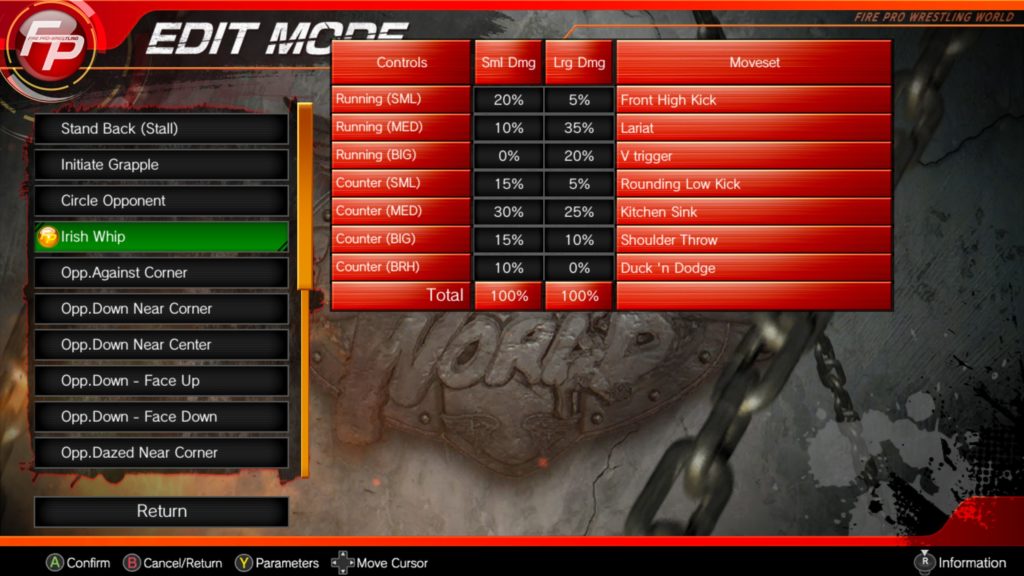
Irish Whip works a lot like back grapple in that you have 7 available options: 3 running, 3 counter and the ability to duck/leapfrog or nothing if using certain fight styles. I tend to focus on there being a running small strike that happens a lot early on and a counter move or two that happens often. Bike will goes for the running front high kick, the roundin glow kick, the kitchen sink and shoulder throw early. All of those moves are relatively lower impact, while at large damage the V-Trigger, one of his specials, starts to come out. But not that much at 20%. Why? Because standing dazed at center has the ability to do more running moves, which is the main place where Bike’s special knee strike will come into play.
In the Corner
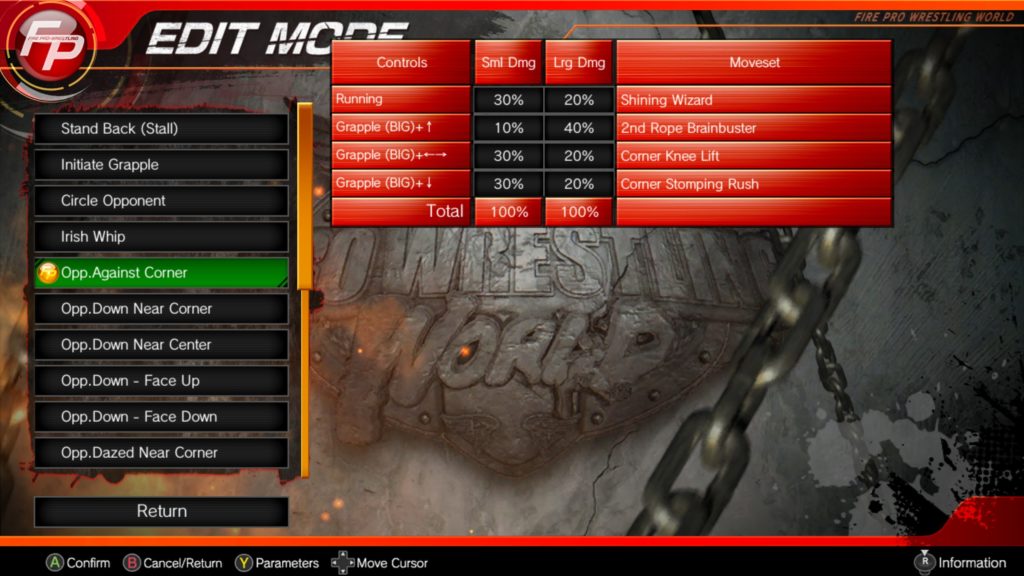
You’ve got four options here, with my idea usually being a running strike as your bread and butter, a strike at left/right. Bike also has the stomping rush at down, which means that he has a whopping 90% at small damage that is based on strikes. The one impactful move is the 2nd rope brainbuster, which has low logic on small and 40% on high. This isn’t Bike’s wheelhouse, but the logic is dynamic enough to where it shouldn’t be dull.
Down Near Corner/Dazed Near Corner
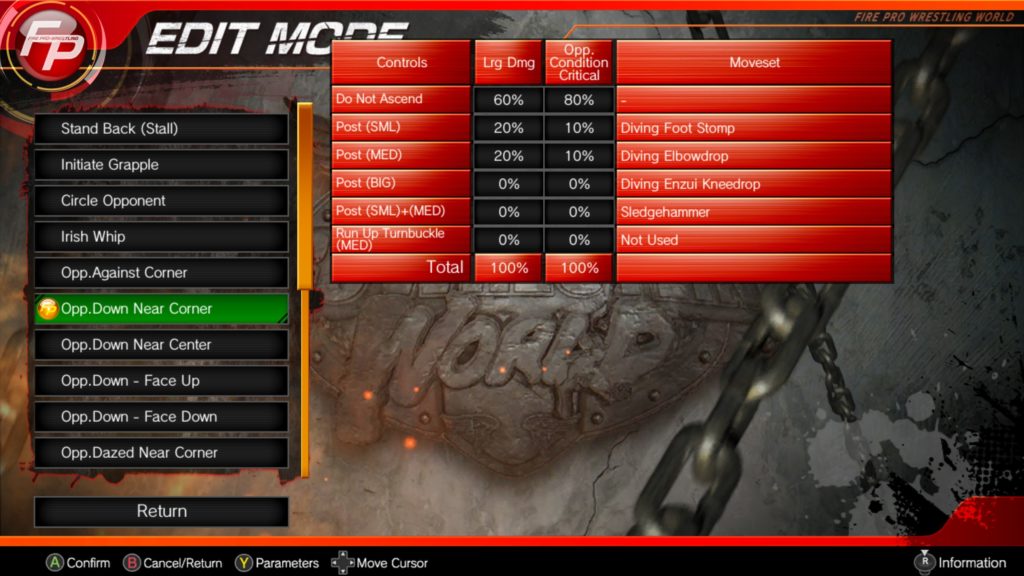
Ah, here we are, one of the strangest and often abused logic positions: dives. Bike is not a high flier, but Bike isn’t afraid to go up top a few times a match to do something damaging. I tend to split things up for two vs. down, two vs. standing. I’ll use the run up turnbuckle for high fliers, but man I wish there were more options in there. So, Bike has 40% at large damage split between the diving foot stomp and diving elbow drop, then at near death (condition critical?!) only 20%. Why? Because this isn’t how Bike looks to finish a match. If you have a character with a special move up here try not to set it too high. Why? Because priorities can make these happen more. Unless you don’t plan on linking moves together. If you aren’t then take note that 30-40% is usually a good range for a special or finisher. Note that small and medium front grapples, as well as X+[] will leave the opponent on the ground, susceptible to these moves. The rest of the BIG moves leave them standing dizzy.
Dazed is similar, except remember that those BIG moves that don’t end in a pinfall or submission will leave your opponent dazed and open for one of these moves. That’s about it. Bike has a special on the diving enzui kneedrop, which he has 30% at critical condition only, in part because there is a priority set for it later on. He has 40% at the swan dive knee attack because he throws a lot of flying knees. At large damage he has 25% on the sledgehammer because he’s not quite there yet and still unsure of himself.
Down Near Center
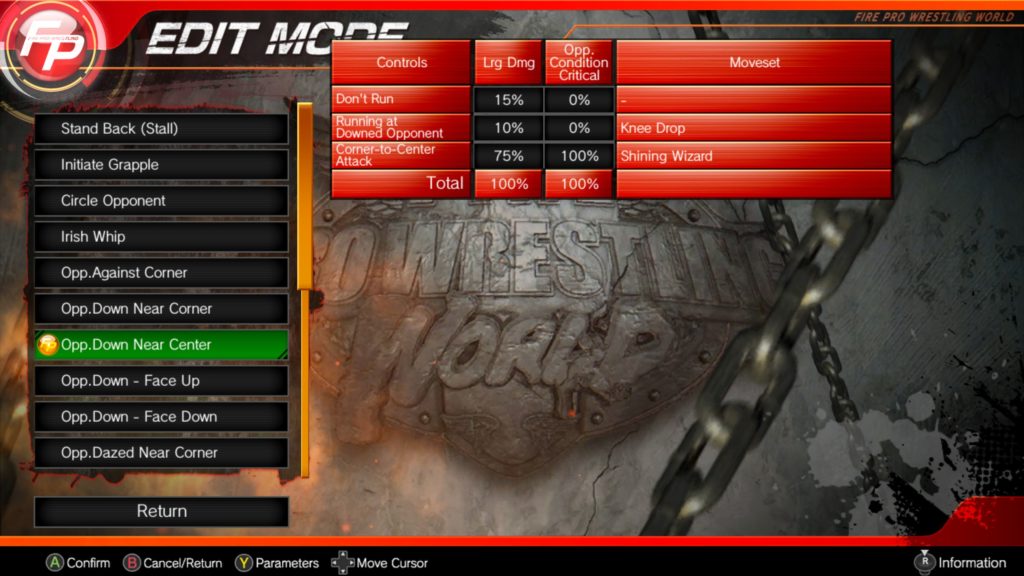
There’s not a ton of meat on the bones here. You’ve got a running at downed or corner-to-center.
Running at downed doesn’t need a whole ton of logic placed on it, or else it’ll happen almost constantly. I usually opt for 10-20%, otherwise it just keeps happening and can get repetitive. Since it’s only one move you probably don’t want to lean on it.
Corner-to-center is, arg, yeah. It was one of the coolest additions to Fire Pro R outside of priority combos. The problem with it is that the characters need to meet hyper-specific position requirements for it to happen, accentuated by certain logic points. Remember that headlock elbow stamp in front grapple? There’s a reason why Bike uses it and why his discretion is at 70%. The C2C Shining Wizard is one of his specials and as you can see it’s set at a whopping 75% and 100%. For someone like me, who is pretty conservative about logic, I think that highlights just how hard it is to get these moves to happen. As it stands now, this may happen once or twice a match, tops. The headlock elbow stamp will drag them towards the center of the ring, thus setting this up. Which is why that is at 8% with 100% on this actual move. If the set up to the move is 8% and it’s set here to happen 100% of the time when the character is down in the direct center of the ring, that means he should attempt it that 8% of the time. There may be a grapple move that places the opponent dead center in line with this move, but it’s pretty rare and hard to rely on. This will be the only time I really tell you to crank something way up and not worry about it.
Down Face Up/Down
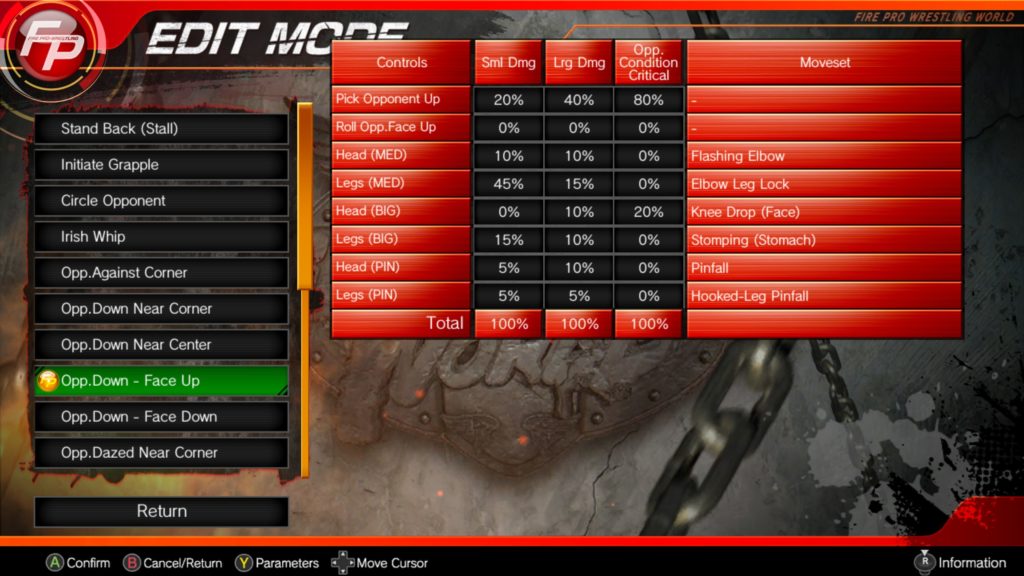
Back in ye old days were had pretty strict rules about this where pick opponent up had to be incredibly high at all times to make the matches “better,” but lemme tell you, it really didn’t. Those days also involved pins having to happen from these positions or pinning grapple moves exclusively, there were no priorities. Now we have priorities.
So how do you handle pins? At small damage you’ll be lucky to get a one count, so put some logic there, but not much. At medium damage is where you want your random pins to be happening. I tend to err on the side of 15-30% combined. Bike only had 15 because he’s an idiot. At critical damage I usually keep them to 0, always, with the lone exception for roll-up moves like the la magistral or Onryo Clutch. Even then I’ll keep it low, although I love flash pin victories.
I like to focus on grounded strikes/stomps/knee drops/elbow drops here, with at least one weardown hold available. At face up Bike has the elbow leg lock and face down he has the JUST Facelock and Rev. Indian Deathlock. Try to keep in mind how your character should be acting with what they do here. A flashier character will go for stuff like knee drops, leg drops, etc., while a more grounded character will go for weardown holds. A heel will look to stomp, punch and grind their opponent down. Always keep that in mind and try to think of how real life wrestlers act. Randy Orton as a heel stomped a lot and did a lot of chinlocks to get heat. Will Ospreay never stops to catch his breath or do a hold while more traditional babyfaces will look to do matwork in the early and mid portions of matches.
Opponent Dazed Near Center
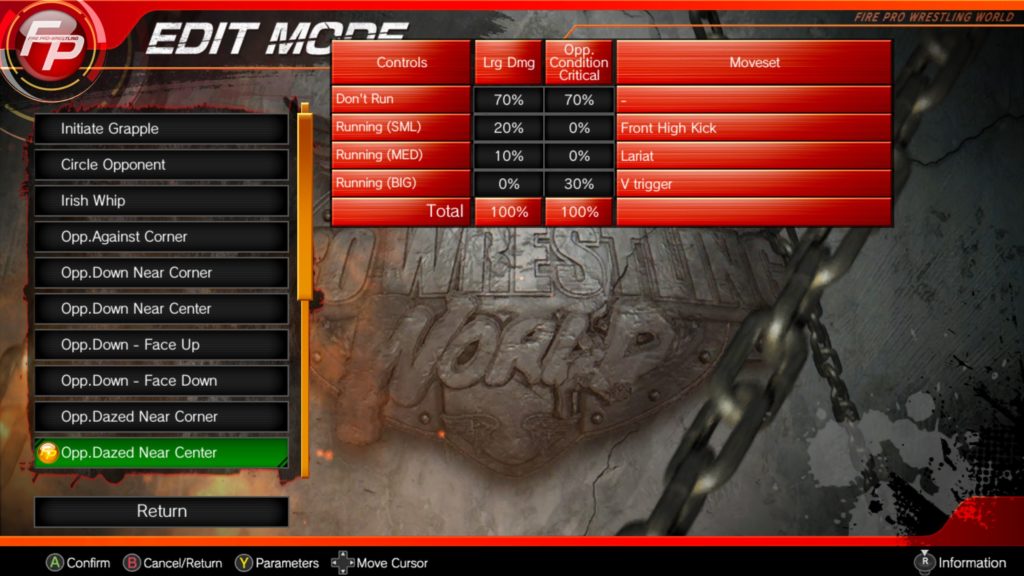
Here is where your irish whip running moves come into play. They can also be chained via priority logic, but for a character that has a running move that plays a big part in the later parts of a match, like a Kojima/Kobashi/Choshu style wrestler who uses a big lariat, this is where you make it happen. Bike uses the V-Trigger as a secondary finisher, so it’s set to 30% here. He’s not much of a lariat guy, so it’s set at large damage at 10%. 30-40% overall strikes feels like the sweet spot to me, otherwise they do way too many running strikes, but this depends on how many grapple moves leave your opponent dizzy.
With Spike adding quite a few strikes that leave characters dizzy from small and medium grapple now it makes a dizzy state happen a bit more than it would previously, so set this accordingly.
Opponent Dazed
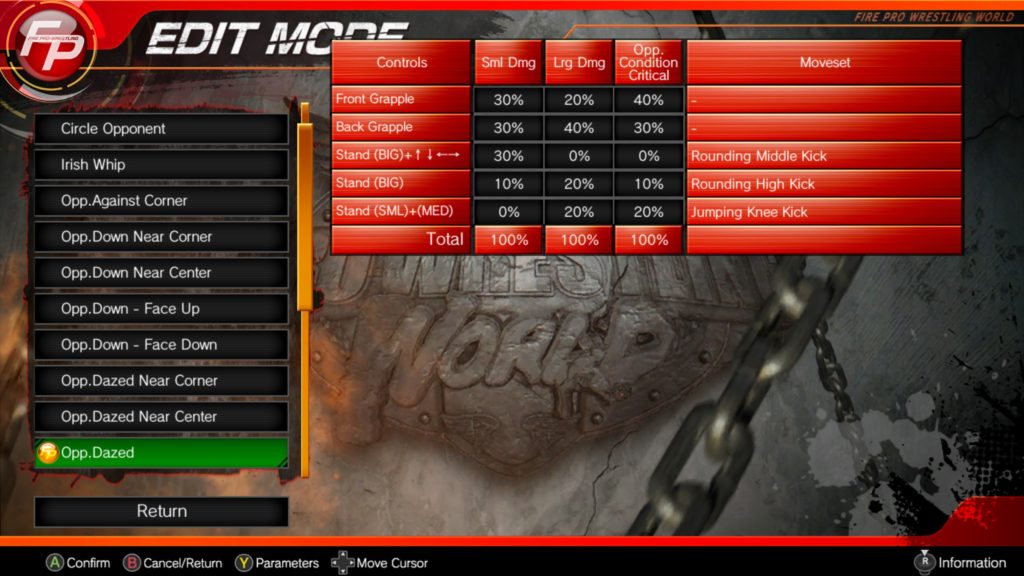
We’re right back to those standing strikes from the beginning, finally. This is where those bigger moves, like the jumping knees, the dropkicks, rolling elbows, etc. should come out and play. You have two options to prompt a grapple and three strikes available. I like to dip into the BIG strikes with medium or weak strikes a lot of the time, as you can see with Bike’s middle kick. I see 20% as the upper side of logic for these moves, if set as a special that’s a hard limit for me. Here’s the other thing: this is how you make back grapples happen if you don’t have a back switch somewhere. This is perhaps the ONLY way to make back grapples happen, which is frustrating, to say the least.
Going for a front grapple from here is probably not needed unless you have a hyper-specific need for your character to daze or pick their opponent up from the mat into the dazed state and follow up with another front grapple, where you probably won’t be able to ensure a specific move will happen. Yeah, I don’t know. But if you want back grapples to happen you should AT LEAST be setting back grapple at 35% or so, I’d say 50%. As you can see, Bike isn’t a big back grapple guy, so I back off there.
MMA Positions
You’ve got three choices here and, depending on if they have a way to access these or not, will most likely rarely ever use these. Don’t think of these as an extension of your moveset because, god, seriously? The MMA mount itself does damage and spirit drain, then the move that happens after does and if you want your matches to last this is not where you should be looking for more moves. That’s not what these are, these are for specific kinds of characters that look to submit or pound at their opponent. I tend to put a transition move where available and put the logic pretty high on those so you’ll get reversals and transitions to emulate early match matwork where possible.
Opponent at Back
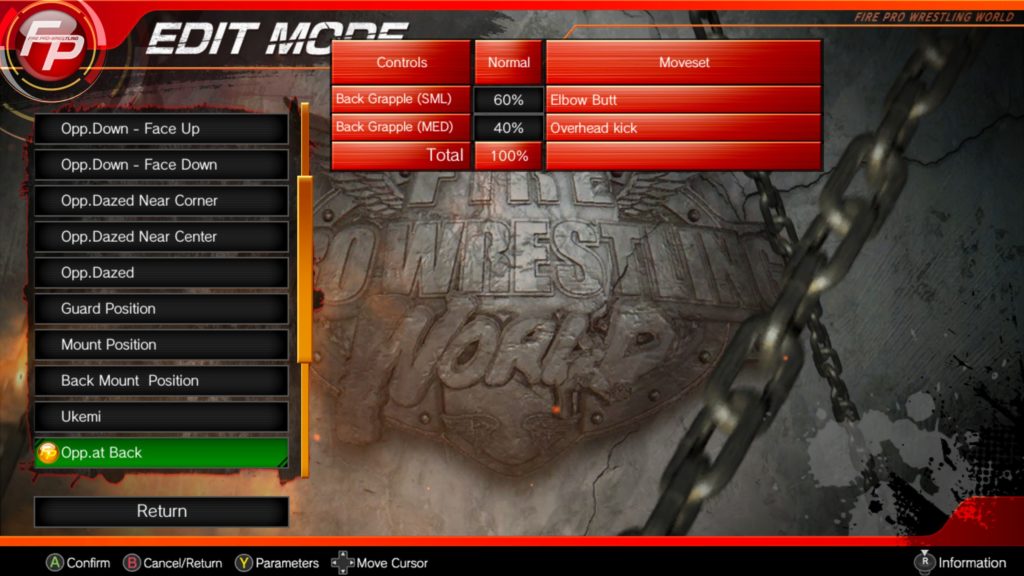
You’ve got two options here. I like to have the elbow in one spot and a more specialized move on the other, which I assign low logic to. 40% on the overhead kick is a lot, but that’s also the character here. If you have a submission or pin here not that they’ll happen a few times a match and could end the match when you don’t want it to end.
Outside of the Ring
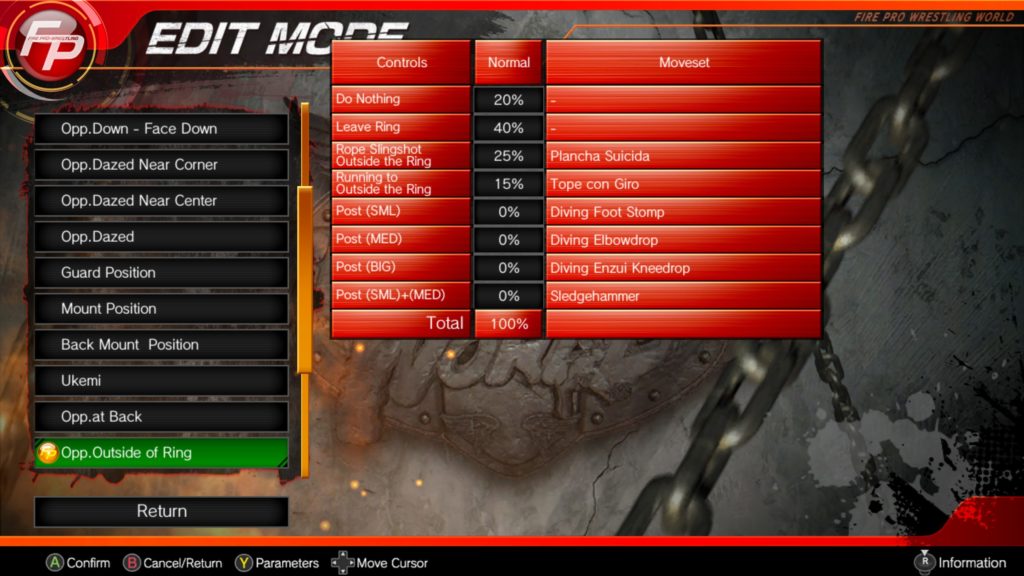
This is where the rest of your high flying comes in. Bike is not a great high flier, so the two main options of slingshot and run are set to 25% and 15% accordingly. If you want these moves to actually happen then crank them up. Like 50% up. Maybe more. Leave ring means they’ll follow an opponent to the outside. The rest are for them to perform actual top rope moves to the outside, think Tanahashi’s diving crossbody.
Performance
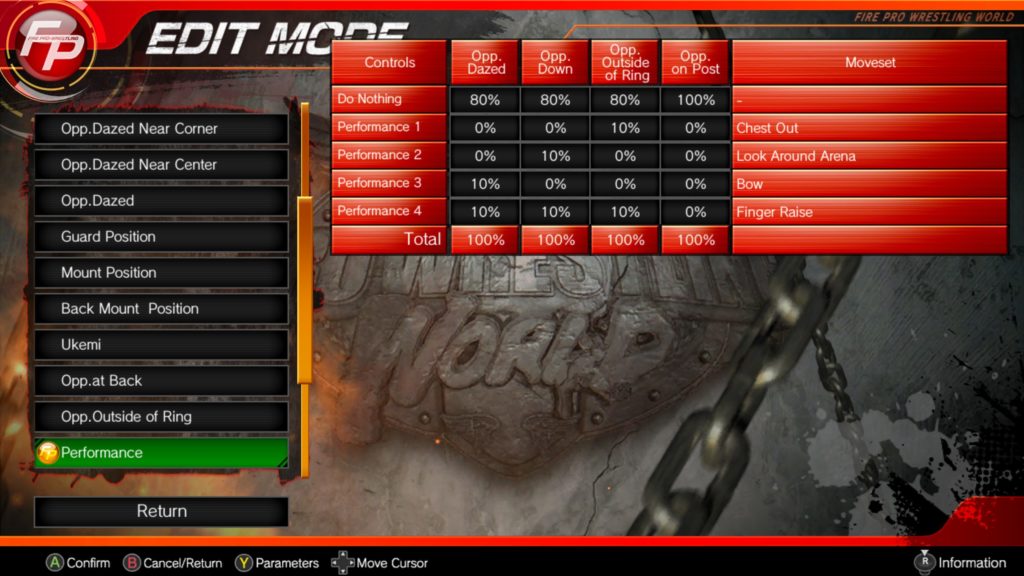
Your taunts! This is straightforward. They can get complicated if used with priority chains, so set them accordingly. If a character is going to taunt when their opponent is down, then go for a hold, don’t set that taunt to happen dazed, ya know?
Personality
My god, I’m sorry. Here we move on from the moves and into some of the more esoteric parts of the CPU logic system.
Ukemi
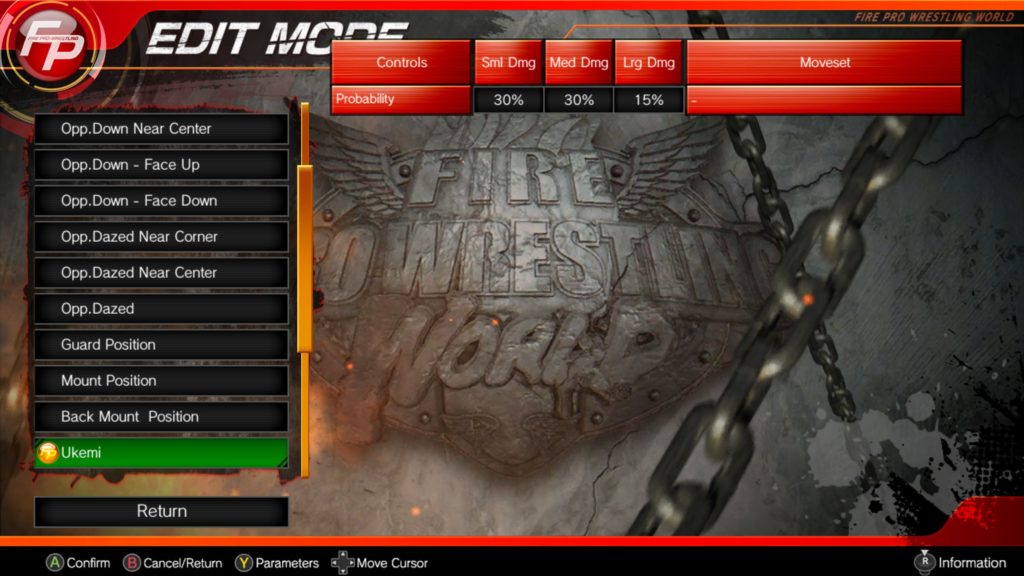
A lot of the rest of Fire Pro logic has been demystified over the years, but Ukemi remains something that most people know how it works, sort of, but still are afraid to touch. The idea behind Ukemi is that there are times when the computer will automatically reverse a move and here you can set the percent of the time that your character will just not reverse and let it happen. But why? Because you bank spirit. Spirit is one of the two big metrics that impact how your character exists in this match, right up there with damage. When the spirit runs out, your character will tap out or be pinned. Ukemi allows a character to take damage at a point in the match, only to bank the spirit damage taken during said move and to bring it back as a boost later on after they’ve gotten to the point of running on empty.
Think of it as a big comeback. Are you starting to see the use of this yet? A babyface making a big comeback is pretty cool, right? That’s what this does. Bike is a babyface, which means he should take some damage and make a comeback later. So, I set him at 30/30/15. It works, for the most part, but remember what this ISN’T, too.
This isn’t that 30% of the time that Bike grapples he’ll take a move to bank it for later, it’s 30% of the automatic reversals.
The default range is about 20/25/10, but I like to do a bit more. This doesn’t do as much as we’d all love it to do, but it does do something. You can’t really rely on it to happen all of the time, but it does happen sometimes and when it does it’s really cool.
Showmanship
Showmanship is mostly how often your character will use an irish whip to throw the character into a different position, which means into the corner or outside of the ring. So, yeah, set this pretty high. Seriously. There is also a mechanic where the higher it is the more they’ll try to save dives for the later parts of the match, the lower the more likely they’ll go for it early. Bike is 95%.
Discretion
Here is something a bit more hard to grasp for a lot of people. Discretion impacts how a character will take risks or opt to breathe. The lower the less likely they are to slow down and take a breath, the higher the more likely.
But that’s not all! The higher the more likely they are to use the tree of woe set up in the corner and there are actually levels that control the headlock elbow stamp. I pick around 70% because they should drag him towards the center. Maikeru on Critical Club has a guide up for personality traits and I’m not going to just regurgitate them here. I will say this, I tend to look at 70-90 as my range.
Flexibility
Flex is perhaps the most straightforward of these. The higher it is, the more likely the character is to play by the match’s rules. If they’re in a deathmatch they’ll take more advantage of it, the same with a cage match, etc. It also impacts how someone will adjust to dealing with an MMA style wrestler who will block an irish whip every time. You character will adapt and instead go for the headlock elbow stamp. Bike is 90%.
Cooperation
This is how likely your character is to work with a teammate or another character. So, a tag worker should be higher. Bike is 85%.
Outside Return Count
How quickly your character will return to the ring. Bike is at 40% so he won’t run back in too quickly, but also won’t get counted out. Brawlers and heels will most likely have a lower percentage, even get themselves counted out on occasion.
Touchwork
This is how often your character will tag out in a tag team match. This used to work differently, but a recent update changed how it worked to be a bit more straightforward. It used to include an internal checkbox that your character would only tag one if they had less health than the partner in the corner, which led to matches involving partners in for entirely too long and never tagging out. Now it’s just a pure, timing based thing. Bike is at 70%. He’ll tag a lot, but not constantly.
Weapons
Weapon usage is something you need to be careful with. 5 – 10% is probably the range where you’ll see weapons, but not constantly. 50% means you’ll basically have nothing but weapons and rarely see grapples. Bike is at 20% which is really high. It means he’ll grab a weapon 20% of the time that he’s near one, which is really a lot. This is, in part, a holdover from when SCFL did a lot more deathmatches. 5% should really suffice for most characters.
Second Interference
This is how likely your character, as a second or manager, will bug the ref during a pin or submission, or slide a weapon under the ring. Heels should be REALLY high, while faces a lot lower. Bike is a passive guy, so he doesn’t do much on the outside, thus he’s at 5%. A heel manager a la a 90s Jim Cornette should be like 70-100%. I’m not kidding. You can, of course, go too high and it’ll drag matches out further, but find the sweet spot for you and the style of matches you’re playing.
Priority Attack
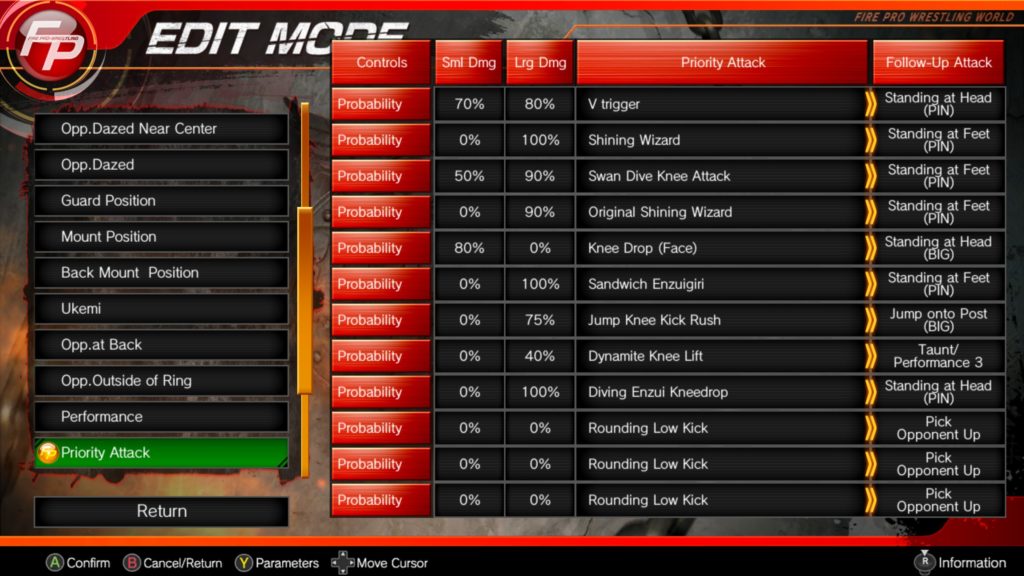
I saved this for last because, well, this is perhaps one of the most crucial parts of Fire Pro’s CPU logic and where you can program a lot of your character’s, well, character. The standard use for this should always be to sequence pinfalls after big moves that you want to end matches. For Bike that means the V-trigger, Shining Wizard(s), Diving Knee Attack and a double team enzuiguri in case he is ever, you know, in a tag team match and wants to try to pin after a double team.
There is a LOT that you can do here. Honestly, I wish that there were more positions to chain, but for right now you can chain moves to ground moves, running moves, top rope moves and taunts. This accounts for a lot of interesting possibilities in Fire Pro. Let’s look at some of the combos for Bike that aren’t purely for pinning.
Knee drop to the face is linked to Standing at Head (BIG), which is, guess what? The knee drop to the face. 80% of the time that he performs the knee drop to the face in the first half of the match he’ll follow up with another. This chains it together to essentially do that until the character gets up, or gives him a 20% chance of stopping. I consider this something like what Stan Hansen used to do, where he’d do multiple elbow drops on a downed opponent. I always loved that spot and use it in a lot of characters like this. If I wanted Bike to pin after I’d probably set this to like 70% and then have knee drop -> pin set to 100%.
The idea here is sequencing. Bike isn’t the best example of this, sadly, although he does have one big sequence, as follows.
Jump Knee Kick Rush -> Jump to Post (BIG)
Diving Enzui Kneedrop – > Standing at Head (PIN)
So, for this sequence he does a standing, big grapple knee strike that leaves the opponent standing dazed, he climbs up the top rope and lands a jumping knee strike, the follows up with a pin.
There’s a LOT that you can do here (I’m reiterating this).
For example, you could do a grapple that leaves the opponent dizzy, then follow up with a taunt, then follow up with a running strike or a top rope strike, which is followed by a pinfall. I’ve been known to sew taunts together as well, depending on the character.
If you wanted to create Hiroshi Tanahashi’s big spot where he does two frog splashes in a row you could have him use the Five Star Frog Splash, which doesn’t end in a pin, as well as the High Fly Flow. You’d sequence the Five Star into the HFF and I’d err on the safe side to set a pin at 100% after the HFF because the opponent could be face down.
If you wanted to create John Tenta’s EARTHQUAKE move, you could have him do the Argentine Appeal stomp when an opponent is down, then follow it up with the running butt splash move.
The Holy Grail of these would probably be The Rock’s People’s Elbow, but I’ll be damned if the character ever really stays down long enough to get the pinfall after it. But, for example’s sake, here’s how it would look.
Spinebuster -> Elbow Taunt
Elbow Taunt -> Running Elbow
Running Elbow -> Pinfall
I’ve always had a hard time with those grounded strikes like the Kawada Face Kick, Kamigoye, etc. being followed up with a pin. You usually need to sequence those from a medium of the X+[] grapple to ensure that they stay down long enough to be pinned.
In Closing
Alright, I’m past 5500 words here, which is, well, a lot of words. That’s well over 20 printed pages all of it dedicated to CPU logic in a video game. I’m sorry. I’m very, very sorry.
CPU logic is not an exact science thanks to the RNG and while there are scientific approaches based on the numbers and how the engine works, I like to think of it as an artform in manipulating the game to giving you what you want. It’s not always precise, but when it works it’s really a great feeling. If you have any questions or suggestions, feel free to reach out. Thanks.
NOTE: We use Amazon Affiliate codes. Any purchase made through said link we receive a small portion of.
